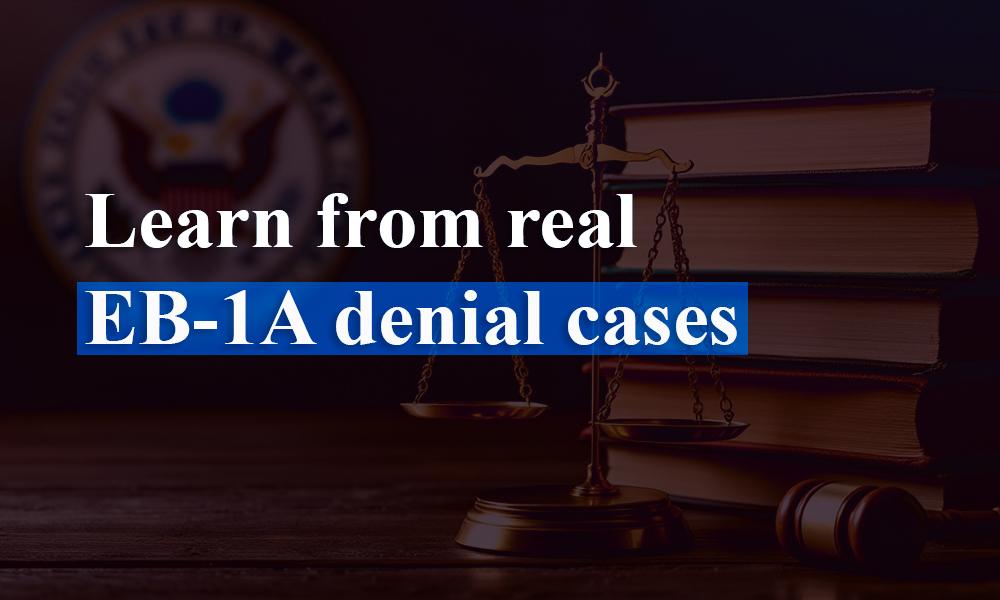Avoid an EB-1A denial. Learn how USCIS decides cases, common pitfalls, and practical lessons to strengthen your evidence or plan your next steps.
If you’ve received an EB-1A denial or you want to avoid one, the most reliable approach is to align your strategy with what the law and USCIS guidance actually require. By regulation, you qualify either through a one-time, major, internationally recognized award or by satisfying at least three of ten evidentiary criteria. “Extraordinary ability” means being among the small percentage at the very top of your field. Meeting “3 of 10,” however, is not the finish line. After checking the criteria, USCIS performs a “final merits determination” to decide whether the whole record proves sustained national or international acclaim and top-of-field standing. The burden of proof is “preponderance of the evidence”—more likely than not—based on relevant, credible, and probative materials.
Why EB-1A Cases Get Denied?
Many petitions stumble because they treat the criteria like boxes to tick rather than building a coherent picture of acclaim. A file can meet three criteria and still encounter a denial if the final merits story isn’t persuasive. Common themes in USCIS decisions include:
- Awards or press with limited stature. Internal/company awards and lightly trafficked media rarely move the needle. Officers expect evidence of selectivity (e.g., jury credentials, acceptance rates) and reach (circulation, audience metrics) so significance can be benchmarked.
- Judging that isn’t selective. Strong judging evidence usually comes from competitive, external roles, editorial boards, grant panels, or program committees, not pay-to-participate listings or routine internal reviews.
- “Original contributions” without adoption. USCIS distinguishes normal professional output from contributions “of major significance.” Show independent uptake: citations, standards, licensed patents, deployments, clinical outcomes, or market adoption.
- High salary with no context. Raw numbers are weak on their own. Use reputable third-party compensation surveys to show your percentile by role, geography, industry, and seniority.
- Misused comparable evidence. Comparable evidence is meant for fields where a criterion “does not readily apply.” Success requires explaining the norms of your field and mapping the alternative indicator to the criterion’s purpose.
- Letters that are descriptive but not probative. Adjectives and inside-baseball praise carry less weight than specifics tied to measurable outcomes and independent corroboration.
Lessons that consistently help
Lead with quality, not volume. Curate a tight record. Build a simple evidence map that states: the criterion, the exhibit, the independent source, and the metric proving significance (acceptance rate, journal rank/citations, circulation, salary percentile, users/revenue, standards adoption). This mirrors how officers evaluate “the petition in its entirety.”
Prove independence. Balance insider letters with third-party validation. Unaffiliated press, juried awards, society rules showing selectivity, and formal invitations to judge or keynote help establish that recognition comes from outside your immediate circle.
Translate achievements into benchmarks. Don’t assume an officer knows your niche. Convert accomplishments into neutral anchors: JCR/SJR journal ranks or citation counts for authorship; conference acceptance rates for judging; credible salary surveys for compensation; market share, funding, user growth, or deployments for critical/leading roles; clinical or technical outcomes for protocols and methods.
Make the final-merits story explicit. Connect the dots so the acclaim appears sustained and cumulative, moving from a selective award to invited judging, to adoption of your work, to independent media coverage, and ultimately to compensation or leadership outcomes. When the synthesis is left implicit, denials often conclude the record doesn’t show you’re among the very top of the field.
Use comparable evidence thoughtfully. For emerging or non-academic profiles (e.g., founders, industry researchers, creative technologists), explain why a criterion doesn’t readily fit and show how your alternative proof serves the same purpose. Provide written context about field norms, selection processes, and impact pathways.
What to do after a denial?
You generally have three paths:
- Refile with stronger evidence if you can quickly cure gaps (e.g., add independent sources, benchmarking, or adoption metrics).
- Appeal to the AAO if you believe the officer misapplied law or ignored probative evidence; you’ll brief why the denial should be reversed.
- Motion to reopen/reconsider when you have new evidence (reopen) or believe the decision was legally or factually incorrect on the existing record (reconsider).
Choose the path by working backward from the denial notice. If the officer questioned independence, add non-affiliated validation. If significance was unclear, add benchmarks. If “sustained” acclaim was doubted, document continuity across multiple years with dated third-party materials.
FAQs
If I met three criteria, why did USCIS still deny me?
Because officers must also conduct a final merits determination. The question is not only whether items fit the criteria, but whether the record as a whole proves sustained acclaim and top-of-field standing.
Is a high salary persuasive by itself?
Only with context. Provide credible surveys and show your percentile by role and location rather than relying on a raw number.
Can industry founders or creative technologists rely on comparable evidence?
Yes, if you explain why a criterion doesn’t readily apply in your field and show how the alternative proof serves the same purpose.
Should I appeal or refile?
It depends on the denial’s reasoning and how quickly you can cure gaps. If you can gather strong independent benchmarks fast, refiling may be efficient; otherwise, consider the AAO route or a motion.
What does USCIS look for in letters—and what are the lessons from denials?
USCIS gives most weight to independent, specific, and verifiable letters. Strong letters come from unaffiliated experts, explain how the writer knows your work, and cite checkable metrics (citations, acceptance rates, journal/venue ranks, users/revenue, standards adoption). Denials often note letters that are heavy on praise but light on data, come mostly from insiders, or assert “major significance” without independent uptake. The lesson: pair every claim in a letter with third-party evidence in your exhibits and translate achievements into benchmarks a non-specialist can verify.
Authoritative references
USCIS Policy Manual, Volume 6, Part F, Chapter 2 (Extraordinary Ability). Available at: https://www.uscis.gov/policy-manual
8 C.F.R. § 204.5(h) Employment-based immigration: extraordinary ability criteria and definitions. Available at: https://www.ecfr.gov/
Kazarian v. USCIS, 596 F.3d 1115 (9th Cir. 2010) two-step analysis (criteria, then final merits). Available at: https://law.justia.com/ or official reporter sources
Matter of Chawathe, 25 I&N Dec. 369 (AAO 2010) preponderance of the evidence standard. Available at: https://www.justice.gov/eoir
AAO Practice Manual and Non-Precedent Decision portal (helpful for patterns and reasoning). Available at: https://www.uscis.gov/administrative-appeals

